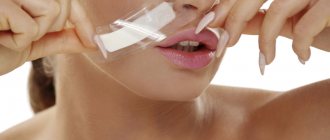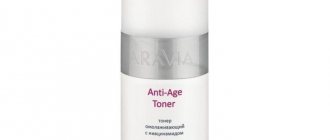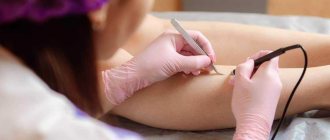Chemical hair removal and depilation Enzyme hair is usually recommended after sugar, caramel or wax hair removal for a more long-term result, as well as after a course of photo or electro hair removal, when only thin hairs remain - for complete removal of unwanted hair. It is based on a chemical effect on the hair follicles with preparations that contain enzymes (enzymes), most often chymotrypsin, trypsin or papain - the same enzymes, but in lower concentrations, are also contained in enzyme peels.
The principle of action of enzymes is simple: they dissolve the peptide bonds of the keratin protein, which is present in our skin cells and is the main structural element of hair. And so that the enzymes penetrate deeper and act more actively, during the hair removal procedure the skin is exposed to a thermoepilator that sends infrared rays. As a result, enzymes penetrate inside the hair follicles and block the “adult” hair follicles and destroy the germinal ones. The nutrition of the follicles is disrupted, they “weaken” and after some time become overgrown, which explains the cessation of hair growth. To achieve optimal results, a course of 5-7 procedures is usually recommended.
Depilation and epilation - what is the difference?
Both of these procedures are suitable for removing hair from any part of the body. Most often, women treat their arms, legs, face, armpits, and bikini area. But still the difference between them is fundamental.
The main difference is the effect on the hair follicle and follicle.
During depilation, the hair follicle is not destroyed. Thanks to this, the removed hair will be able to grow back after some time. Some types of depilation involve removing the hairs along with the bulb, and some - only the subcutaneous part of them, the bulb remains in place. Moreover, if hairs are to be pulled out, new ones will grow thinner and softer. Depilation must be repeated constantly: from several times a week to once every one to two months.
When epilating, the impact falls specifically on the structure of the follicle - it is gradually or immediately destroyed, and the hair in this place will never grow again.
This occurs under the influence of a laser (laser hair removal), bright flashes of light (photoepilation), electrical discharges (electroepilation), and sometimes all at once: ELOS hair removal combines the effects of a laser, flashes of light and electricity simultaneously.
To completely destroy a hair follicle, one time is not always enough: usually you need to complete a course of 5-15 sessions to say goodbye to unwanted hair forever. As a rule, fine blond hair is more susceptible to damage than coarse dark hair.
Shaving
Thanks to men, humanity has accumulated positive and centuries-old experience in the field of shaving
. It (shaving) was and remains a fast, easy, effective and cheap way to remove hair.
Previously, it was generally accepted that shaving hair repeatedly in one place stimulates increased hair growth. It has now been clearly proven that this is not the case. But, we repeat, women still do not dare to solve some problems of excess hair “like a man”: probably, prejudice and tradition are too strong. Let us repeat: no one is left in a state of numbness by a woman shaving her legs, but for some reason it is impossible to imagine a woman shaving her facial hair. The production of razor blades, razors, and pre- and post-shave creams is a thriving multi-million dollar industry that has not been undermined by the slow and gradual rise in popularity of other hair removal methods. Women's machines, as a rule, are somewhat different in shape and are made of plastic colors - blue, pink, light green, etc. However, no one has yet proven that they are fundamentally different from men's machines. In any case, men who by chance used female machines did not notice any significant difference, either during the procedure or when evaluating the result.
Types of depilation
There are several types of depilation. Some methods involve complete hair removal from the root, while others only remove the visible part of the hair. Each of them has its own advantages, disadvantages, and contraindications.
Shaving.
Perhaps the most popular, accessible and ancient way to make your body smooth. There are records that indicate that the ancient Greeks removed hair from the entire body using a narrow blade attached to a wooden handle.
For a long time, a razor was practically no different from a knife blade, and those who wanted to get rid of vegetation often received cuts. It was only at the end of the 19th century that the world saw the first version of the safety razor.
Today, shaving is a comfortable and quick procedure. Manufacturers produce comfortable women's razors with two, three, even five blades, equipped with grooming strips, non-slip handles and replaceable cassettes.
The advantages of shaving as a type of hair removal are that it is cheap, fast and does not hurt at all. You can buy a razor in almost any supermarket, and you can use it every day at home - no special preparation other than water and shaving foam is required, and you also don’t need to grow your hair to a certain length. You can take the razor with you on a visit or on vacation - it takes up almost no space in your cosmetic bag.
The main disadvantage is that the razor does not remove the hair root, but only cuts off its upper (supercutaneous) part. Because of this, the hair grows back quite quickly, and at the same time it becomes stiffer: after just a couple of days, stubble that is unpleasant to the touch appears on the skin - the woman is forced to repeat the procedure over and over again.
For this reason, shaving is not suitable for removing vellus hair on the face - after a while it will become even more noticeable. In addition, if used too often or improperly, the razor often causes skin irritation and leaves cuts where infection can occur. To avoid this, dermatologists advise treating the razor and skin with an antiseptic in advance.
Preparation: To reduce irritation, you can pre-steam your skin with warm water. Hair can be any length.
How long is it enough: depending on the speed of hair growth, you will need from 1 to 3 times a week.
Contraindications to shaving depilation - wounds, irritation, dermatitis. If there are many raised moles on the skin, the procedure is carried out with caution. In this case, it is better to choose a razor with a floating head.
Geling.
This chemical depilation appeared in beauty salons quite recently. Its essence is to dissolve the inner surface of the hair follicle and weaken the connection of the bulb with it.
First, a cleanser is applied to the skin to exfoliate dead skin cells and prepare the hair for removal. Then comes the main stage. A gel is applied for a few minutes, which penetrates to the very base of the hair, making its bulb soft and pliable. The master removes the gel with a napkin along with the fallen hair, then moisturizes the skin with tonic.
The advantages of gelling are speed, painlessness, comfort (the composition is not sticky and does not require rinsing), the ability to be used on any area of the body, and a small number of contraindications. It can be done in any season, even for girls with varicose veins.
Disadvantages - you need to grow your hair (4-5 mm), the possibility of an allergic reaction to the composition, incomplete removal of dark, coarse hair the first time, dependence on hormonal levels.
Preparation : optimal hair length is 5 mm. You can do gelling on your face at least 7-10 days after hardware treatment or injections. On the day of the procedure, do not apply any products to the area where it will be performed. If you are not sure whether the hair length is suitable, send a photo to the specialist and clarify this.
How long is it enough: usually one such depilation every 4-6 weeks is enough.
Contraindications to gel depilation are pregnancy, menstruation, recently performed hardware or injection procedures (if geling is done on the face). In the first couple of days after treatment, you should not take a steam bath, take a bath, sunbathe, or apply cream or deodorant.
Cream depilation.
A type of gel depilation for home use. Cosmetic stores sell creams that act on hair roots in the same way as gel.
The difference is that the cream is softer, and the set does not always contain products for preliminary cleansing and final moisturizing. Sometimes the cream does not work the first time, so the procedure has to be repeated.
The advantages of cream depilation are low price, painlessness, and the ability to do it at home.
Cons – not suitable for the face; low efficiency, especially with cheap creams; the possibility of allergies; It’s not very convenient to do it yourself.
Preparation: grow hair at least 4-5 mm, cleanse skin and dry it well. Read the description of the process in the instructions and follow it strictly.
How long does it last: depending on the quality of the composition, it may last for 3-4 weeks.
Contraindications – skin disorders and diseases; pregnancy, allergy to the components of the cream.
Sugar depilation or sugaring.
A popular method of removing excess hair in beauty salons, the history of which dates back to Ancient Persia. A small plate of caramelized sugar is applied to the skin opposite the hair growth, pressed tightly, and then torn off with a sharp movement in the direction of hair growth.
A plastic paste is made from sugar, water, and citric acid. Some manufacturers add honey, caring components - essential oils, vitamins, and skin-soothing additives. You can make it at home, the main thing is to achieve the right consistency and not get dirty.
Advantages of sugaring: natural hypoallergenic paste composition; its low temperature (36-38 degrees); peeling effect for the skin; less ingrown hairs; new hairs grow thinner and softer. In addition, removing hairs according to their growth makes the procedure less traumatic and painful. This means that sugar depilation is more suitable for delicate and intimate areas - face, armpits, Brazilian bikini. In addition, it can be done on girls with minor manifestations of varicose veins.
Cons – you need to grow hairs to a certain length for each zone, otherwise there will be no effect; irritation may occur; long labor-intensive process; not always effective on coarse hair; the highest cost of all types of hair removal.
Preparation: hair length 4-6 mm; on the day of depilation, do not apply cream, deodorant, oil, or cosmetics to the area where the treatment will be carried out. You shouldn't sunbathe for a few days.
How long is it enough: Sugaring is usually done once every 3-4 weeks.
Contraindications to sugar hair removal:
- allergy to paste components;
- skin disorders and skin diseases;
- pregnancy (I and III trimester);
- varicose veins 3-4 degrees;
- diabetes.
During menstruation, depilation is also not recommended - the pain threshold decreases, so the sensations can be very unpleasant.
Waxing (waxing).
This method of hair removal is similar to sugaring, but instead of caramel paste, a melted polymer material – wax – is used. It may consist of pine resin, beeswax, rubber, and synthetic additives. It is applied in the opposite direction to the hair growth, and removed in the opposite direction using a fabric strip. The method is quite popular and effective, but more painful and traumatic.
The most important advantage of waxing is its higher speed compared to sugaring. You can also make it at home yourself if you buy a cassette or a jar of wax and melt it in a water bath. For application you will need a flat stick - a spatula.
Cons – painful, not suitable for girls with a low pain threshold; wax that is too hot can cause burns; hair grows more often; traumatic for the top layer of skin; irritation and bruising; sticky marks after the procedure on the body and clothes.
Preparation: grow hairs 4-6 mm; do not apply cream or other products on the day of the procedure; a day before going to the salon, you can treat your skin with a scrub; a few days in advance - do not sunbathe; two weeks in advance - do not do hardware treatments.
How long it lasts: as a rule, wax depilation is repeated every 3-5 weeks.
Contraindications: the same as for sugaring. Pregnancy, severe forms of varicose veins, diabetes, skin diseases, allergies.
Electrodepilation.
The name of the procedure can easily be confused with electrolysis, but these are two different hair manipulations. In the first case, the hair follicle is destroyed by an electric discharge, and in the second, the hair is removed using a device on which a rotating shaft with small tweezers is attached.
They quickly take turns capturing the vegetation and removing it along with the bulb. This device is better known as an electric epilator (or depilator). They are sold in hardware stores and are designed for use at home.
The advantages of electrolysis are accessibility and economy (one device works for several years); it takes up little space; it can be used anywhere at any convenient time (battery-powered wireless epilators are sold); The sets contain attachments for different zones and massage.
Cons: soreness, especially in the armpits and bikini area; not suitable for the face; low-quality devices allow hairs to pass through; the process may take a long time.
Preparation: you need to grow your hair 3-5 mm, clean and dry your skin.
How long is it enough: it is recommended to repeat the procedure every 3-5 weeks.
Contraindications: low pain threshold, skin diseases and injuries, pregnancy, diabetes.
Trading (trading, trading).
This is the removal of fine hair using a strong silk thread soaked in an antiseptic. It is fixed in a certain way on the fingers and moved so that it curls and captures the hairs. The technique was developed specifically for the face: with the help of trading, vellus hair is removed from the upper lip, on the chin, and clear lines of the eyebrows are formed.
Pros: delicate process, minimal pain.
Cons: Suitable for face only.
Preparation: Remove cosmetics from treated areas.
How long does it last: 2-3 weeks.
Contraindications : damage and irritation to the skin.
Contraindications
Despite the presence of caring components and the delicacy of the effect, such a cream still remains an aggressive chemical environment that can have a negative effect on the skin. Therefore, the product has quite a few limitations in use. It is not recommended for:
- Age less than 14 years;
- Thin, sensitive skin in the application area;
- High susceptibility to allergic reactions;
- Excessively dry skin;
- Ongoing contact dermatitis at the application site, outside it, other ongoing allergic reactions;
- Skin diseases in the application area;
- Diabetes mellitus;
- Metabolic disorders of another type;
- Problems with hematopoiesis, blood circulation;
- Presence of areas of integrity violation in the application area, near it - abrasions, scratches, cracks.
People can also experience discomfort when using the compositions. Those with sensitive mucous membranes, since irritation on the mucous membranes located close to the treatment area may begin, even if the composition did not come into direct contact with them. It is not recommended to inhale the vapors of the composition.
Skin care after depilation
This is an important stage, which determines how quickly the epidermis will recover, since any hair removal is, although minimal, still an injury. If the procedure was performed in a salon, the specialist will tell you at the very end what should and should not be done in the next few days in order for the result to be enjoyable. For those who do hair removal at home, the same rules apply.
In the photo: Lovely post-depilation spray with orange essential oil.
● In the next 2-3 days, you should not swim in the pool or take a bath, go to the sauna, sunbathe, wear too tight clothes, engage in active sports, or use cream and deodorant. Exposure to water, sweat, hot air and ultraviolet radiation, and fabric friction further irritate injured skin and follicles. A rash, burning, and redness may appear.
● It is not recommended to touch the treated area with your hands too often to avoid infection, as the follicles still remain open.
● Be sure to apply a soothing cream after depilation. These can be products with the addition of panthenol, aloe vera, squalane, tea tree oil, shea butter, jojoba and other natural ingredients.
● When the skin has recovered, you can use a cream that slows down hair growth. Then you will be able to slightly delay your next appointment at the salon.
● You can lightly exfoliate your skin a couple of times a week to prevent ingrown hairs. The reason for their appearance is that thinner hairs cannot break through the stratum corneum of the skin, and therefore begin to grow “downwards”, forming unsightly painful nodules and suppuration.
Thermolysis
Thermolysis has been used in Europe since the 40s (according to some sources even since the 20s) of our century. It is based on the action of high frequency and low voltage alternating current. The current is supplied through a thin needle, which is inserted into the skin to the depth of the hair follicle, where local heating occurs, sufficient for the follicle to collapse. Thermolysis is a very painful procedure in which the use of surface aerosol anesthetics is clearly insufficient. Many patients have to undergo standard local anesthesia (lidocaine, novocaine, trimicaine, etc.). However, according to some reports, this may subsequently enhance local hair growth. In addition, anesthesia provokes another problem: the liquid medium of drugs can dramatically change the parameters of the entire procedure, and it will not give the desired effect. Another disadvantage of thermolysis: this process is quite slow (each hair takes a few seconds) and it is with this that the greatest danger of subsequently obtaining small atrophic scars, folliculitis and even local septic manifestations is associated: local overheating during thermolysis is too severe a test for the skin.
Salon or home waxing?
Manufacturers of depilatory products and devices admit that girls will be able to use them at home. There is now a lot of information available on sugaring, wax, gel and cream depilation - instructions, articles, reviews, testimonials, lessons on YouTube.
If you want to save money and feel confident, you can try to do any type of hair removal yourself. But be prepared for the fact that it won’t work out the first time.
A visit to a salon with a trained specialist gives more guarantees and takes less time. A competent master will not forget about pre-treatment of the skin, monitor the consistency and temperature of the composition, wipe off the gel in time, and apply a disinfectant at the end of the session. At the same time, you do not need to wash your apartment of liquid wax and sticky sugar.
Blend method (from the English blend - mixing, mixing)
This method is a logical and reasonable attempt to combine two previous methods, one of which at the time of the invention of the blend method was the oldest and most studied (thermolysis), and the second was popular and effective (electrolysis). Thus, the device for this type of hair removal combined both high-frequency alternating and constant galvanic effects of current. With the blend method, a staged effect on the follicle is carried out. During the first stage, a thermolytic reaction occurs around the follicle with dehydration of the surrounding (perifocal) tissues. The second stage - electrolytic - provides a galvanic reaction, during which the formation of a much smaller amount of alkali is sufficient for the final destruction of the follicle. Modern blend epilators are provided with a single computer unit for selecting the optimal ratio of electro- and thermolytic phases, depending on the individual characteristics of the patient. Due to the double impact on the follicle, the chances of its final destruction are doubled. But at the same time, the blend method managed to combine the disadvantages of its “parents” - the speed of the procedure is low, and the likelihood of scars and folliculitis is higher than we would like.
Transformations of a laser beam
Laser hair removal is being promoted all over the world most actively and even, one might say, aggressively. It gets to the point of ridiculousness: some Internet sites, in response to the request “hair removal,” offer only laser methods, pointedly hushing up others, as if they simply do not exist! This state of affairs - and we have already written about this - is very typical for the market for the supply of cosmetic services. The development, study, and implementation of laser technologies is a very expensive undertaking, which now, naturally, must pay off. And therefore laser hair removal is a very expensive method of hair removal. But at the same time, no one, including specialists, undertakes to claim that this new and fashionable method allows a radical and final solution to the problem. It is clear that, like everything new and progressive, laser hair removal should be promoted in every possible way. However, this should happen in compliance with honest democratic principles, that is, without infringing on other types of de-epilation and hair removal, and leave the patient the opportunity to make an independent choice, taking into account many interests, including, of course, financial ones. The undoubted advantages of laser hair removal are almost complete painlessness, non-damage to the skin surface and the ability to directly affect a group of follicles. The first optimistic reports about laser hair removal appeared in the early 90s. The method uses the principle of directional light flux. A laser beam that creates a high radiation power density is capable of producing a significant local thermal effect, which is accompanied by reactive coagulation of the follicular zone, vaporization (evaporation) and carbonization (charring) of the tissues surrounding the follicle. Simply put, the follicle is burned, “dried out” and “charred.” Special computer support for laser systems allows for precisely targeted selective action, so that all these effects occur in the area of the hair follicle. The laser effect is only possible if there is some kind of absorbing medium in the path of the beam. Otherwise, spontaneous deactivation of the beam occurs (in other words, it simply dissipates). In the skin, such a medium is melanin, the content of which in the hair shaft is very high. The heat from the hair shaft is transferred to the follicle (anagen phase again required). There are controlled physical mechanisms by which thermal damage to the surrounding skin can be minimized. Darker hair has more melanin, therefore, its follicles are better destroyed during laser hair removal. There are three main types of hair removal lasers: ruby, alexandrite and neodymium. The first one is the most tested (by the way, in America it is the only one - so far - that has an authorization certificate issued by the FDA). Information about other lasers is contradictory. The ruby laser generates red radiation with a wavelength of 694 nm, producing light pulses with a duration of about 3 ms, providing an energy flow of up to 40-60 J/sq. see Pulse repetition frequency - 1 Hz. Since the target here is exclusively the melanin of the hair follicle, the laser is not applicable for tanned skin: firstly, it will dissipate energy; secondly, there is a high risk of soft tissue damage. In addition, we repeat, it does not “recognize” blond hair. It is interesting that after ruby hair removal the follicle does not die, but goes into the catagen and telogen phases. That is, the cessation of hair growth is achieved by disrupting the normal growth cycle. The Alexandrite laser generates radiation with a wavelength of 725 nm, pulse durations are 2.5 and 20 ms. The pulse repetition rate is 5 Hz, which means it is five times faster than a ruby laser. Has the same restrictions on skin type and hair color. A neodymium laser (range 1064 nm, pulse duration 100 ms) has its own characteristics. Before the procedure, depilation is performed with hot wax, then a carbon microsuspension is rubbed into the skin. It is believed that in this case, coal particles become clogged into the freed hair follicles. It is clear that follicles with such content perfectly absorb radiation. The coal quickly heats up and “explodes”, destroying the follicle. It is believed that laser hair removal usually requires 10-15 sessions at intervals of up to 1 month. According to an expert in this field, Dr. Nina Tsisanova, 72% of patients get rid of unwanted hair within a year; 23% - in 1.5-2 years; 5% - for a period of more than 3 years. Complications after laser hair removal
the same author includes pigmentation disorders, peeling, itching, erythema, swelling, blisters, angioectasia, pain factor and post-burn scarring.
Flash method (from English flash - flash)
Note:
exactly “flash”, and not “fast”, as many Russian electrologists and equipment sellers believe, based on an inaccurate translation. In essence, the flash method is an improved thermolysis, since the main principle of operation is the same galvanic effect. But the direct current used here refers to very high frequency currents (2000 KHz). Taking into account the fact that the duration of exposure to one hair is extremely short (0.01 - 0.09 seconds) and the needles have mandatory isolation, trauma and pain during the flash method are practically not expressed. Needless to say, there is a single computerized control unit that allows the selection of optimal modes.











